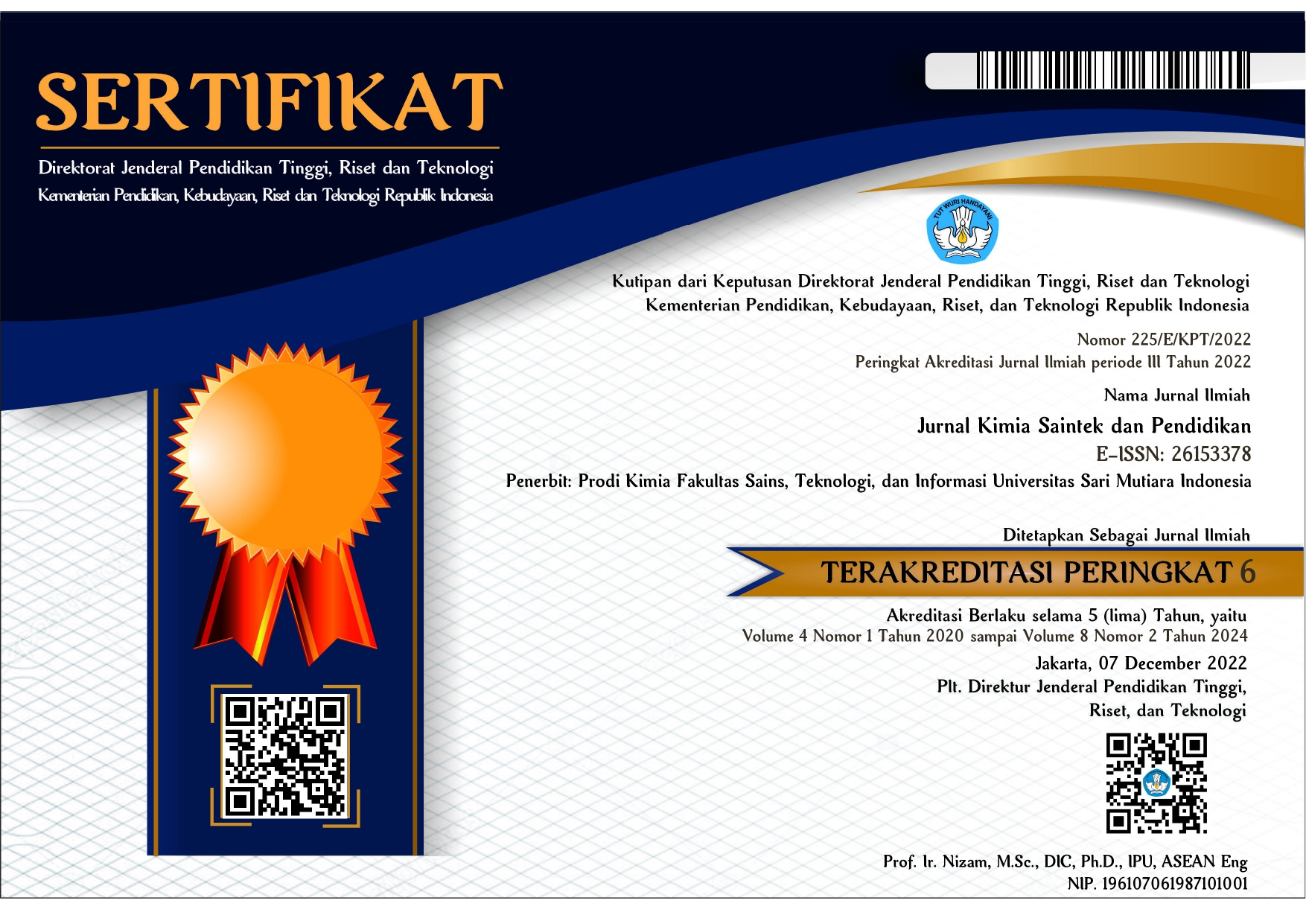EFEKTIVITAS ARANG AKTIF CANGKANG TELUR BEBEK DAN KULIT DURIAN SEBAGAI ADSORBEN UNTUK MENURUNKAN KADAR BILANGAN PEROKSIDA DAN ASAM LEMAK BEBAS PADA MINYAK GORENG BEKAS
Keywords:
Cangkang Telur Bebek, Kulit Durian, Arang Aktif, Asam Lemak Bebas, Bilangan Peroksida., , Bilangan PeroksidaAbstract
Penggunaan minyak goreng bekas secara berulang kali pada suhu tinggi akan menyebabkan kualitas minyak goreng dan nilai gizi makanan yang digoreng menurun sehingga mengakibatkan terbentuknya senyawa aldehida, keton, dan bau tengik, yang berdampak buruk bagi kesehatan tubuh. Untuk memurnikan dan meningkatkan kualitas minyak goreng bekas sehingga dapat digunakan kembali dengan aman dalam mengolah makanan dilakukan melalui proses adsorpsi dengan arang aktif dari cangkang telur bebek dan kulit durian. Proses pembuatan arang aktif dari cangkang telur bebek dan kulit duriantelah berhasil di sintesis melalui proses karbonisasi di dalam furnace pada suhu 600 °C selama 2jam. Penelitian ini bertujuan untuk menurunkan kadar bilangan peroksida dan asam lemak bebas pada minyak goreng bekas sebelum dan sesudah 3,4 dan 5 kali penggorengan dengan dan tanpa pemberian arang aktif dari cangkang telur bebek dan kulit durian. Penentuan kadar bilangan peroksida dilakukan dengan menggunakan metode titrasi iodometri sedangkan penentuan kadar asam lemak bebas dilakukan dengan metode titrasi asidi alkalimetri. Berdasarkan hasil penelitian yang telah dilakukan arang aktif dari cangkang telur bebek dan kulit duriansetelah diaktivasi dengan H3PO4 4N sudah memenuhi persyaratan yang ditetapkan oleh SNI No. 06-3730-1995, diperoleh kadar air 2,5 %, kadar abu 5 %, daya serap iod 746 mg/g, kadarkarbon terikat 86%. Kadar bilangan peroksida pada minyak goreng bekas sebelum dan sesudah 3, 4 dan 5 kali penggorengan dengan pemberian arang aktif sampel A kadarnya 0,0386 meq/kg, sampel B kadarnya 0,0414 meq/kg, sampel C kadarnya 0,0423 meq/kg, sampel D kadarnya 0,0429 meq/kg. Semua sampel masih memenuhi syarat SNI 01-3741-2002 yaitu 10 meq/kg O2. Kadar Asam Lemak Bebas pada minyak goreng bekas sebelum dan sesudah 3, 4 dan 5 kali penggorengan setelah pemberian arang aktif sampel A kadarnya 0,2186%, sampel B kadarnya 0,3571%, sampel C kadarnya 0,4826%, sampel D kadarnya 1,3845%. Semua sampel masih memenuhi syarat SNI 01-3741-2002.
Abstract : Increased waste each year is very influential on environmental sustainability. For this reason, serious treatment is needed for this problem. The business that can be done is to utilize the waste into economically valuable material. In this case, a research was carried out on the utilization of beverage cans as raw material for alum production. In previous studies, aluminum content in beverage cans was found to reach 83.98%. After the study, it was found that aluminum content in alums made from beverage cans contained 4.57% better than commercial alums which were only 0.37%. The use of used cooking oil repeatedly at high temperatures will cause the quality of cooking oil and the nutritional value of fried foods to decrease, resulting in the formation of aldehydes, ketones, and rancid odors, which adversely affect the health of the body. To purify and improve the quality of used cooking oil so that it can be safely reused in food processing through an adsorption process with activated charcoal from duck eggshells and durian bark. The process of making activated charcoal from duck eggshells and thorn bark has been successfully synthesized through the carbonization process in the furnace at 600 ° C for 2 hours. This study aims to reduce the levels of peroxide and free fatty acids in used cooking oil before and after 3,4 and 5 frying pans with and without administration of activated charcoal from duck eggshells and durian bark. Determination of the level of peroxide number was carried out using the iodometric titration method while the determination of free fatty acid levels was carried out by the alkalimetry asidi titration method. Based on the results of research that has been carried out active charcoal from duck eggshell and durian bark after activation with H3PO4 4N has met the requirements set by SNI No. 06-3730-1995, obtained a moisture content of 2.5%, ash content of 5%, absorption of iodine 746 mg / g, carbon dioxide bound 86%. Levels of peroxide in used cooking oil before and after 3, 4 and 5 times frying by giving activated charcoal sample A levels are 0.0386 meq / kg, sample B levels are 0.0414 meq / kg, sample C levels are 0.0423 meq / kg , the sample D level was 0.0429 meq / kg. All samples still meet SNI 01-3741-2002 requirements, which are 10 meq / kg O2. Free Fatty Acid levels in used cooking oil before and after 3, 4 and 5 times frying after giving activated charcoal sample A levels are 0.2186%, sample B levels are 0.3571%, sample C levels are 0.4826%, sample D levels are 1 , 3845%. All samples still meet SNI 01-3741-2002 requirements.
Keywords : Duck Egg Shells, Durian Bark, Active Charcoal, Free Fatty Acids, Peroxide Numbers.









 This work is licensed under a
This work is licensed under a 

.png)

